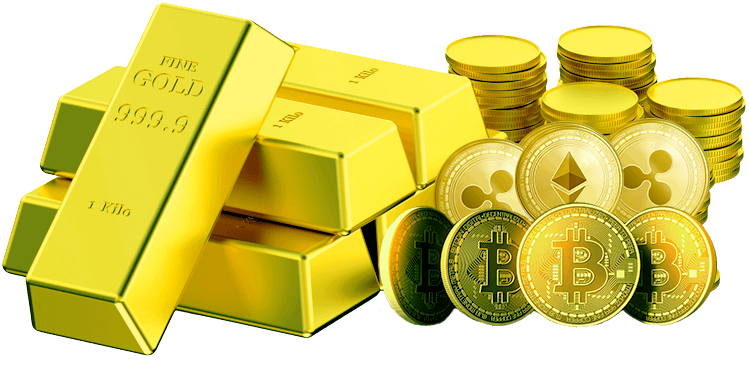Why Buy Gold ETFs
Gold ETFs are currently being used to allocate assets, and it basically means that investors are putting a percentage of their portfolios in physical gold. Analyzing patterns of inventory we see that investors in ETFs are generally there for the long haul, versus engaging in short-term speculation and day trading. It’s hard to tell exactly what percentage is going into institutions. The research indicates that private clients, institutions, and mutual funds are the most heavily involved in ETFs. Market professionals account for a relatively minor percentage at just 10-15% of the total. It’s important to note, however, that even though ETF gold investment has been moving so fat, the 25 million ounce holdings are just a tiny sliver of the estimated nearly 5 billion ounces of bank, investment, and jewelry stores.

Gold acts as a hedge against inflation and other risk factors
When the sub prime and credit problems of 2007 hit, nervous investors put money into gold as a kind of safe haven. Gold ETFs were invested in a lot more heavily during that time. Stocks of ETFs rose gradually throughout the sub prime and junk bond crunch and stock market downturn. From mid-summer to autumn of 2007 when Bear Stearns’ activities fomented the financial problems, gold ETFs’ bullion stocks rose from a pre-crisis level of 20.8 million ounces to 25 million ounces. This little increase was highly significant. Hedge funds were dumping a lot of stuff to pay back their bank borrowings and give money back to investors who had become disenchanted with investing. They also dumped gold, because they had to sell liquid assets. So, after going up to $684 an ounce from $659 an ounce, it went back down to $653 during the tough market period of August 2007. Gold volatility was very low, however.
Even though hedge funds, advisors, and other speculators were selling gold, it was clear that other investors were looking into safe havens for their money. Sovereign bond prices rose. Money moved into gold. Many investors in recent years have built up their holds of physical gold. They had concerns about credit binging, too much speculation, inflation, and the possibility of an economic or financial crisis. Even though they were moving a lot of money into gold, those trades were hard to quantify. Most of the trading occurred through bullion banks in Hong Kong, Zurich, London, New York, and Tokyo. These banks don’t publish their inventory.
ETF gold stocks are a good indicator, though. Even though they’re a tiny percentage of the gold market, they have clearly observable stock movements and usually indicate the goals of medium and long-term investors, as opposed to just speculators. Since late 2003, they rose more than double to 25 million ounces, which sent gold to a Millennium high of $760.
ETF gold stocks are also an indicator of safe havens. Because every share of gold ETF is 10% of an ounce of gold, someone who purchases 1000 shares, for instance, is purchasing 100 ounces of gold. Gold ETFs are trustees on behalf of investors for gold bullion put into certain banks. This gold is put into “allocated accounts”. What that translates to is that the gold is held on behalf of gold ETF investors. They are the only owners. The gold bars are put into the banks’ vaults, and they’re marked and put onto shelves. They have unique labels placed on them, and they become the property of the gold ETF owner. Even though the bank holds the gold, it isn’t the property of the bank. The bank just stores it there safely. So, if the bank goes under, its creditors can’t claim that the gold is a bank asset. However, regular bank deposits, unallocated gold, gold futures, and options derivatives don’t have this protection.
So, basically, investors who think a financial collapse or bank failure could happen are willing to pay a bit more in storage and insurance fees to garner this kind of protection. The fees are different based on the amount of gold stored with the bank. The fee is a little higher for smaller or medium size holdings. To compare, gold ETFs have a charge of .4 percent each year for management. The fee includes storage and other types of expenses, and they’re the same whether you’re a small or big investor.
If you look at gold ETF stock movements, you can see that long-term investors are keeping their gold. Some analysts believe that the big infusion of cash to pacify banker fees could lead to more inflation. Others believe that holding gold is a good idea during a period of heightened risk. Whatever reasons they have, wanting to hold gold in distinct allocated accounts with high storage and insurance fees or in gold ETFs, is just one more layer of protection.
Gold ETFs can bring in some income
There has been a recent surge in demand for gold ETFs, and that demonstrates a move into gold, but also the growing awareness that ETFs are a cost-efficient and easy method of trading bullion.
The market has grown a lot, and it is a lot more liquid now, so hedge funds and other smart investors are going both long and short in ETFs. So, a new window has opened up for funds and other big-time investors to lend them and earn interest. One of the big downsides for pension funds that invest money in commodities is that they don’t bring in income. The price of metals or any other commodity holdings has to go up faster than the cost of dealing, storage, insurance, and everything else. If institutions, investors, and pension funds have gold ETF holdings, they can lend it out just like they could with any stock. So, the gold ETF has become a useful asset for pension funds because the interest on the loans helps with the cost of keeping the asset.
Based on the level of general interest rates, the yearly lending rate for gold ETFs has moved from 1% to 2.5%, and it is more than individual shares, according to gold ETF brokers. That rate is actually five times the yearly ETF management fee of .4%, which offsets costs associated with holding the asset. It is more than the lease rate on physical gold, too. At the same time, the gold backing of the ETF is safely stored away in the vaults, specially allocated to the individual investor. So, the gold can be held as a long-term investment as part of an asset allocation diversification plan. It is still uncertain whether lending can take place on a big scale. The market has become liquid enough that hedge funds and big-time investors can trade in big blocks. To demonstrate the amount of liquidity in the market, the overall investment in StreetTRACKS Gold Shares (GLD), for instance, was almost 20 million ounces worth nearly $15 billion. Because every single gold ETF is backed by about 1/10 of an ounce of gold, the number of GLD shares alone is now about 190 million with a total market cap of about $15 billion. Toward the end of 2007, daily trading in GLD was about $1 billion. GLD only came to the market in 2004, but it’s already a much more actively trade stock on the NYSE than many older, more established gold mines. Gold mining stocks will always be popular with investors, as long as gold is going up. Investors like the mine because something called operational leverage causes the shares to go up by a greater amount than the gold price. Exploration and ore results are also interesting to investors. When gold goes down, however, mining stocks go down by a greater amount than bullion. The financial and operational leverage that mines offer can bring in more profits but also cause some risks. There are so many different types of risks. They include corporate governance problems, political problems in Third World countries, geological forecasting mistakes, and many other problems. On the other hand, gold ETFs go up and down based on the price of gold.
GLD volumes have become more popular to institutions and individual investors because the ETF is 100% matched to bullion. They have also discovered that GLD is very accessible for trading. They can go long or short with small spreads and minimal dealing costs. One analyst said that GLD’s average spread has been the narrowest of any ETF and has been better than that of most big cap stocks in the US. The average has been around $.02, which is about 20 cents an ounce. Compare that to other spreads in the OTC spot gold market of around $1 to $1.50 an ounce for deals of between 5,000 and 10,000 ounces.
Big institutions and individual investors can be flexible with their ETFs and lend and withdraw the loans quickly, depending on what their financial needs and asset allocation strategies are.



